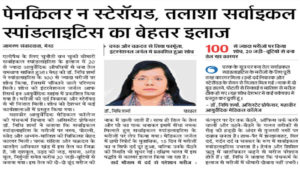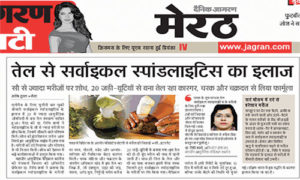What is Cervical Spondylosis
Spondylosis is degenerative osteoarthritis of the joints between the centre of the vertebrae or neural foramina. If severe, it may cause pressure on nerve roots with subsequent sensory or motor disturbances, such as pain, paraesthesia, and muscle weakness in the limbs. If vertebrae of the neck are involved it is labelled Cervical Spondylosis. It is a common age related degenerative condition in the area of intervertebral disc of cervical spine with gradual formation of spondylotic ridges, osteophytic facet, ossification of the post longitudinal ligament and shock absorbing disc shrink slowly presenting with symptoms related pressure on the spine, associated nerves and blood vessels.
Clinical Features of Cervical Spondylosis:
Spinal symptoms – Neck pain, neck stiffness, medial scapular pain and shoulder pain.
Root compression (Radiculopathy) – The range of movement is reduced particularly during rotation and lateral movement of the head. Occipital headache and vertigo also noted. Pain starts from the trapezius ridge (C4), tips of the shoulder (C5), anterior part of the arm (C6), radial forearm (C6), and often the thumb (C8) or all the fingers (C6, C7, C8).
The clinical signs are motor weakness and wasting of proximal muscles of the hand depending on the roots compressed. Sometimes Lhermitte’s sign or ‘Barber’s chair sign’ can be elicited.
Investigations:
Biochemical Examinations- CBP,CUE
Radiological Examinations- X-rays, C. T. Scan, Myelogram, MRI
Other tests include E. M. G. (Electromyogram) & Nerve conduction studies.
Imaging Studies:
Plain cervical radiography (Anteroposterior and Lateral view) – It demonstrate disc space narrowing, osteophytosis, loss of cervical lordosis, uncovertebral joint hypertrophy, apophyseal joint osteoarthritis, and vertebral canal diameter.
CT Scan- It demonstrates small lateral osteophytes and calcified opacities in the middle of the vertebral body.
MRI- It is a considerable advance in the use of imaging to diagnose cervical spondylosis.
Cervical Spondylosis and Ayurveda
According to Ayurveda Cervical Spondylosis can be correlated with Vishwaachi Vat.The word vishwachi is derived from two words- “VISHVA” dhatu & “ANCH” prtyaya. VISHVA means all/whole/entire/universal5. ANCH means to move/turned to/directed towards.Thus viswachi literally means to spread throughout. It also means paralysis of the arms and the back7.
Definition of Vishvachi:
तलं प्रत्यंगुलीनां तु कंडरा बाहु पृष्टत:।बाह्वो कर्म क्षय करी विश्वाचीति सा स्मृता।।
Vata invading the kandara of the hasta tala (palm), pratyanguli (fingers) and bahu prusta (back of the arm) causing bahukarma kshaya (loss of function of the upper limb) is known as viswachi.Vagbhata also defined it like sushruta but mentioned ‘Bahu chestapaharani’ (hampers the function of upper limb) instead of ‘Bahukarma kshaya’.Acharya Charaka has mentioned that Nidana Sevana aggrevates Vata and this Prakupita Vata gets accumulated in Rikta Strotas and gives rise to various generalized and localized diseases.
In Viswachi, the prakupita vata while moving all over the body settles in greeva pradesa making it the adhistana. As the khavaigunya is in greeva, vata fills those strotas doing soshana of the sleshaka sleshma of greevakasheruka sandhis along with greevakasherukaasthi vikara, thereby affecting vatavaha nadis in turn leads to dusti of kandaras of Bahu.
NIDANA OF VISHWACHI
The factors, which are responsible for the vitiation of Vayu can be considered as the Nidana of Vishwachi Vata also.
CHIKITSA (MANAGEMENT) OF VISHWACHI:
In Vishwachi vitiated Vata that originates from the Pakvashaya afflicts the Asthi Dhatu further vitiating the Snayu and Kandars and produces the disease.
Sushruta in vata vyadhi chikitsa mentioned treatment of Vishwachi as sira vyadha along with general line of treatments prescribed for vata vyadhi should be adopted.
The general line of treatment of vata vyadhi is as follows.
SNEHANA KARMA:
In Vishwachi, Bahya Snehana may be performed in the form of Abhyanga, Avagaha, Parisheka etc. It helps in overcoming the khavaigunya of the asthi dhatu by snigdhata.
SWEDANA KARMA:
Swedana by its Sthambhaghna, Gauravaghna and Shitaghna properties works on Shula and Stambha symptoms of Vishwachi Svedana also helps in the liquefaction of the Dosha there by rectifying the Margavarana or clearing the Strotas.
MRIDU SHODHANA:
Mrudu Virecana in the form of Anulomana is performed such that it may not lead to the Riktata of the Pakvashaya.
SIRAVYADHA:
Sushruta [1] and Vagbhata have advised Siravyadha for Vishwachi.The Sira located about 4 Angula above or 4 Angula below the Kurpara Sandhi should is selected for the procedure.
NASYA KARMA:
Nasya karma [2] is specially indicated for urdhwa jatrugata vata vikaras. Acharya Sushruta specially mentioned the snehana nasya in Vata Vyadhi.
Read in Hindi.
आज कल की जीवनशैली में मोबाइल फ़ोन और कंप्यूटर का उपयोग बहुत ज़्यादा बढ़ गया है जिसके कारण आज की आज की पीढ़ी अधिकतर अपनी गर्दन को झुकाकर काम करने की आदी हो गई है ।इस वजह से अधिकांश लोगों में गर्दन का दर्द सिर में भारीपन सिर का दर्द हाथों में झनझनाहट हाथों में दर्द ऐसे लक्षण देखने को मिलते हैं ।
मोबाइल फ़ोन और कंप्यूटर की अधिक उपयोग एवं विकृत जीवनशैली के कारण आज कल सर्वाइकल सपोंडाइलोसिस के मरीज़ों की संख्या बढ़ गई है जिसका मुख्य इलाज दर्दनिवारक दवाइया है। लेकिन पंचकर्म के द्वारा इन रोगियों को बिना किसी दर्द निवारक दवाई के उपयोग के भी ठीक किया जा सकता है।
पंचकर्म विशेषज्ञ डॉक्टर निधि शर्मा ने पिछले 3 वर्षों से ऐसे सैकड़ों मरीज़ों का इलाज पंचकर्म द्वारा सफलतापूर्वक किया है। डॉक्टर निधि शर्मा के अनुसार ऐसे मरीज़ों में चक्रदत्त में वात रोग अधिकार में वर्णित तेल का नस्य एवं विशेष रूप से तैयार औषधि द्वारा अभ्यंग उपरांत स्वेदन अत्यंत कारगर होता है।
इसके लिए जो तेल तैयार किया जाता है उसमें दशमूल, बला, रास्ना, निर्गुंडी आदि लगभग ३० औषधियों को गाय के घी एवं तिल के तेल में पाक किया जाता है।इस तेल का उपयोग नस्य के साथ ही अभ्यंग में भी होता है।स्वेदन के लिए घी, सेंधा नमक, नींबू आदि औषधियों से लेप तैयार किया जाता है।
इस चिकित्सा का सबसे बड़ा लाभ यह है की इसमें रोगी दर्दनिवारक औषधियों के दुष्प्रभाव से बच जाता है।





You must be logged in to post a comment.